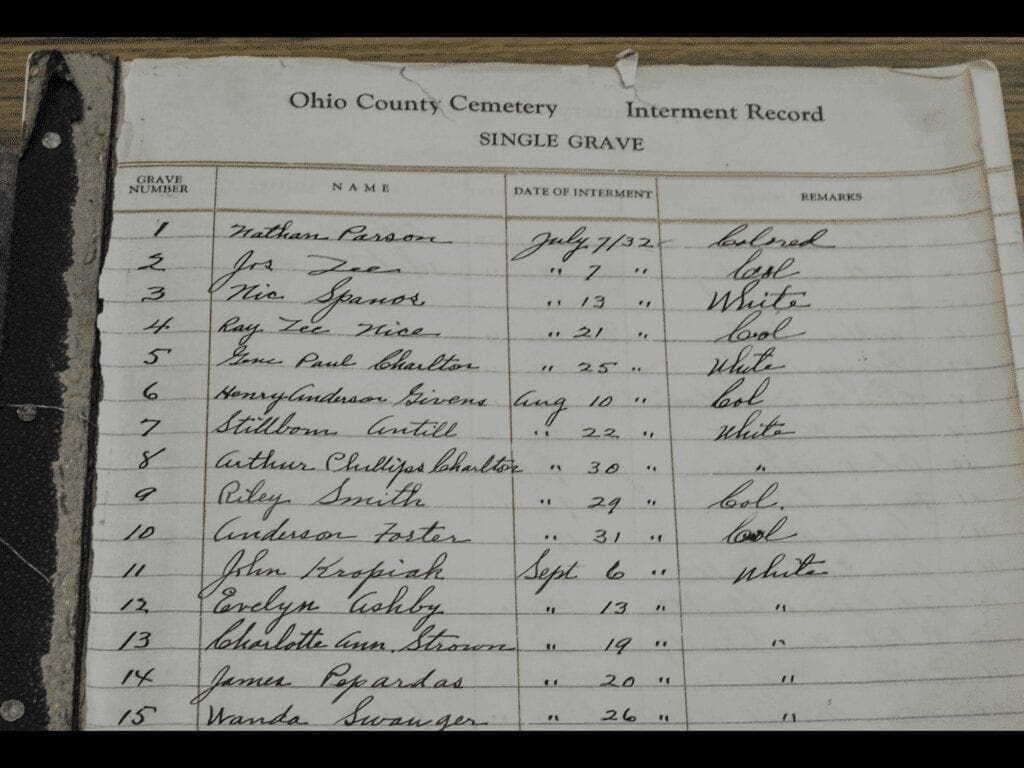The first person interred at the County Farm Cemetery in Roney’s Point took place on July 7, 1932. His name was Nathan Parson, and according to the interment record, the man was “colored.”
To find his gravesite, though, is impossible.
According to the records kept by the Ohio County Commission, the County Farm Cemetery has been sparsely utilized since July 1973, but Anita Blue was interred in Roney’s Point in March 1987 to rest with a relative, Katherine Cook, who was buried there on Nov. 12, 1932. Cook was No. 24, and technically Blue was No. 762, but neither grave can be located today, and the same is true about the majority of the others because the burial ground has not been maintained for many years.
In fact, even the sign that once marked the entrance to the cemetery is no longer hanging from the posts that remain in place today. A photo published by findagrave.com displays the sign resting against an iron gate in September 2011, but the fencing is no longer in place, as well.

The County Farm Cemetery is located along Roney’s Point Run Road past County Farm Road, a narrow street that leads to the remnants of the Schmulbach Mansion, the former tuberculosis/mental health hospital, and to a half dozen homes. A small stream runs along the border of the graveyard, but a concrete bridge was constructed to allow visitors to cross.
The “remarks” in the interment record book between 1941 and 1961 referred to the dead as an “inmate” or as “not an inmate” in reference to the legendary hospital, a former facility many believe holds captive some of the lost souls who died there. Some of the pages reveal children were buried there, too, after they were “still born” or discovered dead in the Ohio River.

On a Dare
For many years since the 1980s, young people from throughout the Upper Ohio Valley have dared to visit the former “insane asylum” with hopes of a haunting experience. Some thought the skeleton of the former mansion was the hospital, but it never served in such a capacity.
Henry Schmulbach, a very popular brewer in the Wheeling area in the early 1900s, constructed the house and began living there in 1911 with his second wife. West Virginia implemented prohibition, however, in 1914, and Schmulbach passed away the next year. His wife, unwilling to live in such a rural area by herself, sold the mansion and more than 400 acres of land to Ohio County.
The property was transformed into the county work farm after the Great Depression began in 1929.
“I am familiar with the property because I used to ride my bike and horse when I was a kid on the county farm from time-to-time,” explained Ohio County Commissioner-Elect Zach Abraham. “I did not spend a lot of time there but rode past it a few times. The farm where I grew up was below the county farm, but I have to admit that I have not been up to the cemetery or the farm for many years. I’ve always remembered it as a very nice area.
“I would personally like to learn more about its history so when we start to review the County Farm in the future, the area will be part of the county assets to review,” he continued. “It would be a good idea to explore how the cemetery could be preserved on some level and seek input from the families who have family members buried there. One idea may be to ask Wheeling Heritage or similar organizations to take a look at it from a historical preservation and restoration project perspective.”

Land of Value
The county farm property is a little more than four miles from the Elm Grove neighborhood in Wheeling, and it is about the same distance from The Highlands and Interstate 70. Southwestern Energy owns an established gas well on the east side of the property, but plenty of acreage remains in every other direction for future development.
Abraham already has recognized the potential.
“The County Farm is a very nice asset that needs assessed for the best use and purpose to serve the county and its citizens,” he said. “From my perspective, I would like to see the County Commission add this to an overall Ohio County masterplan development strategy by reviewing, collaborating, and seeking input from the local neighbors in the Roney’s Point area along with (elected officials in) the village of Triadelphia.
“I also think we should discuss the property with other organizations and interested parties as may be appropriate,” Abraham said. “That way we will be able to determine areas of future growth, utilization, and what’s possible with preservation.”

The former asylum is rotting inside and outside, but the building remains standing with no visible threat of an imminent exterior collapse. Many of the building’s windows have been broken by vandals, and there are signs of previous breaking-and-enterings. The interior houses two large community bedrooms on each far side, and in between those quarters are treatments rooms, offices, and an operating room. The basement of the building is where the coal was stored and burned for the boilers, but once there were a couple of cages for the more unruly of patients.
What remains of the Schmulbach house, though, makes the area a very dangerous place. A fire caused by vandals, according to former Ohio County Sheriff Tom Burgoyne, in the early 1970s left the mansion as the skeleton it is today, but those bones now are frigid and fragile.
Both structures rest on rare level land and for any development to take place, the demolition of both would be necessary.
“Ohio County has a rich history, and it extends to the County Farm with these buildings on the property, but in many ways different from the cemetery,” Abraham said. “I think it will take some conversations with the commission members and a few other organizations to seek thoughts about the best path forward.
“I would be in favor of starting fresh in these two areas on the county property after assessment to see how there could be some historical memorial provided if they were demolished,” he suggested. “It could be an example of how the past could potentially inspire and transform the future.”


